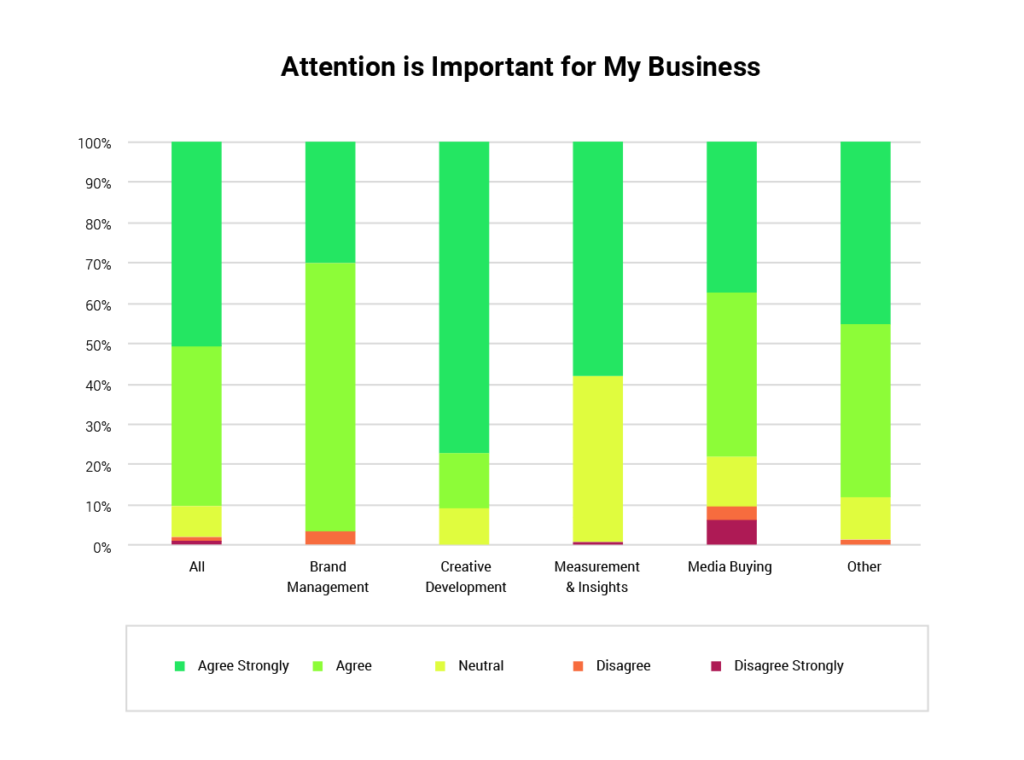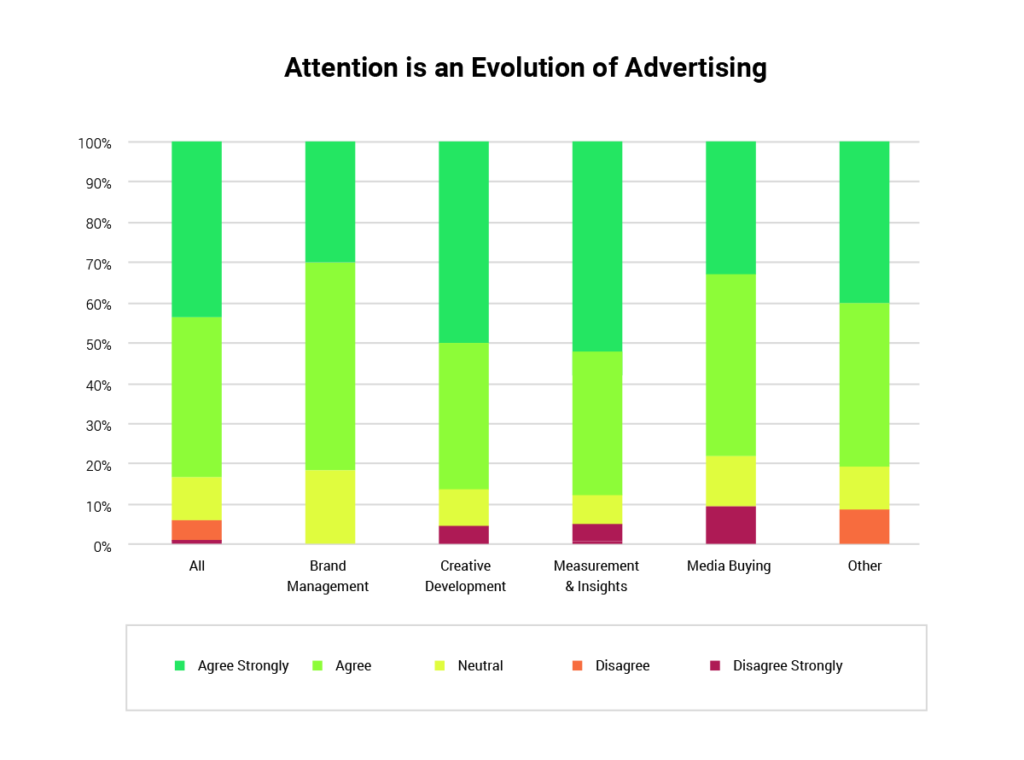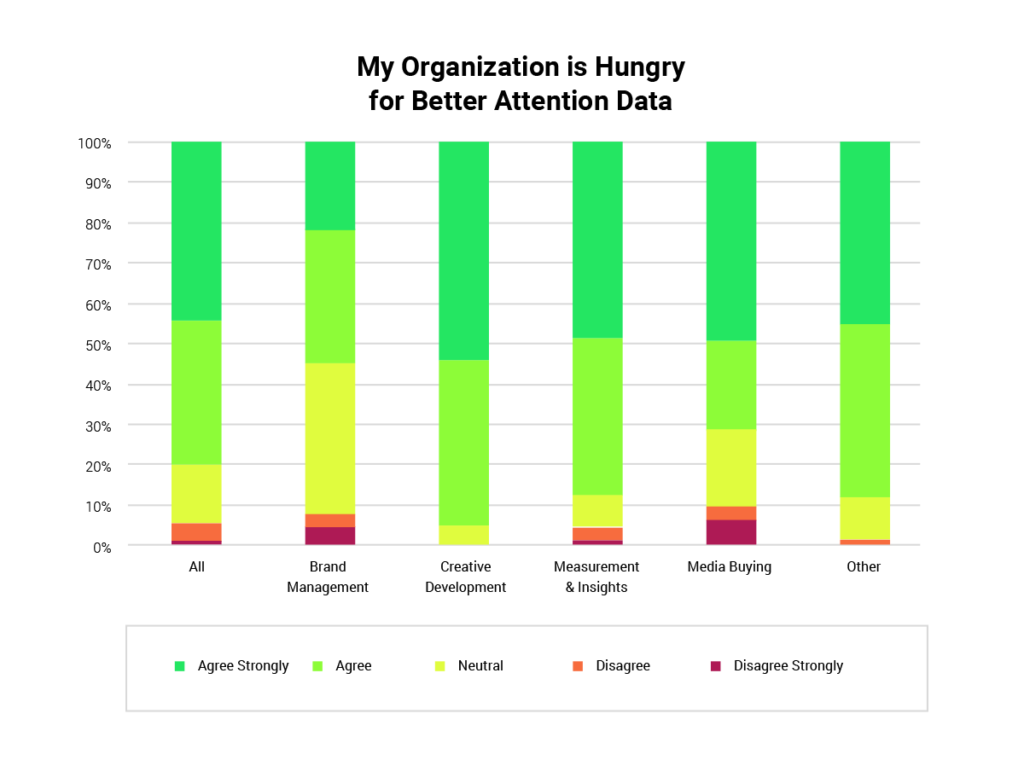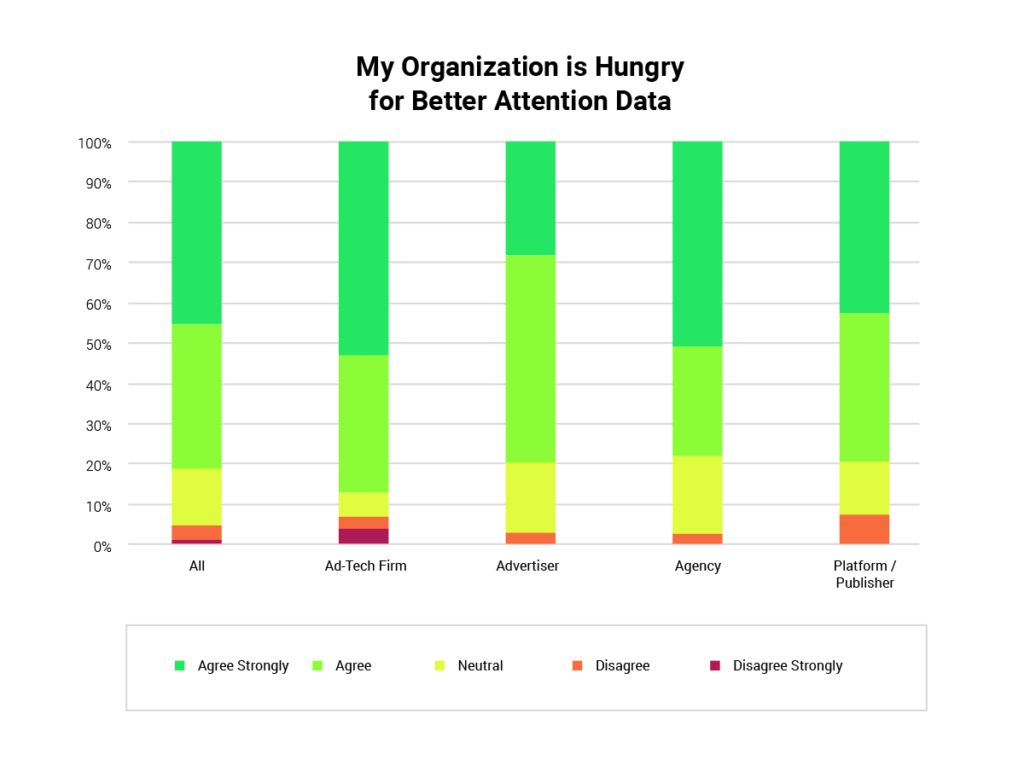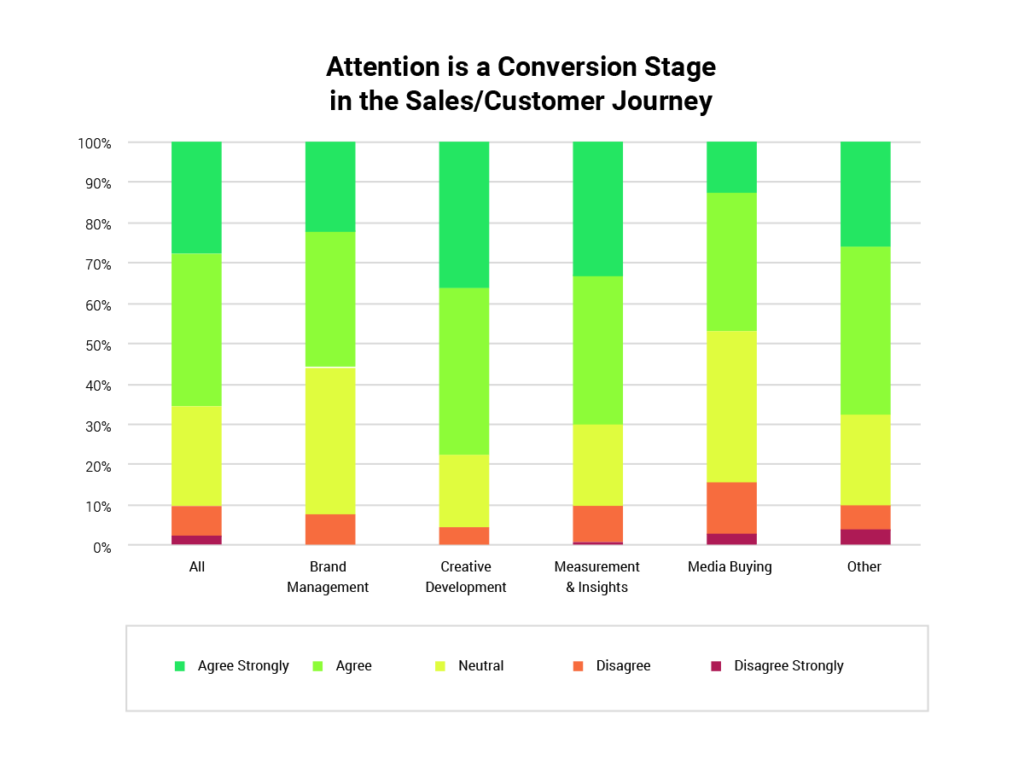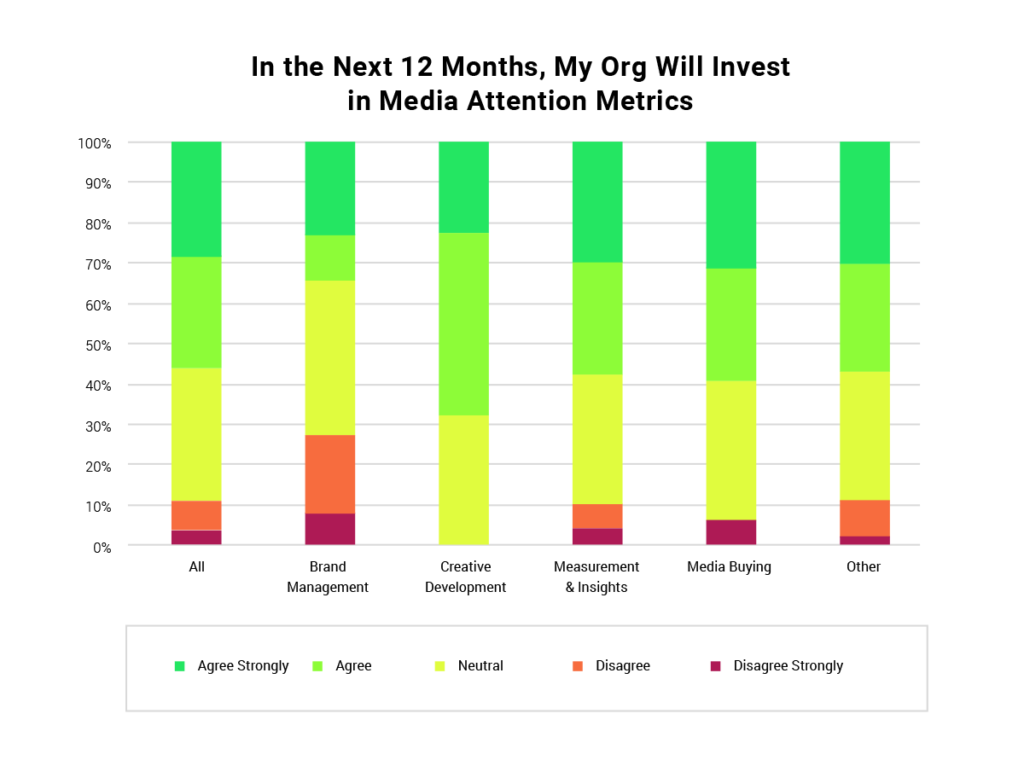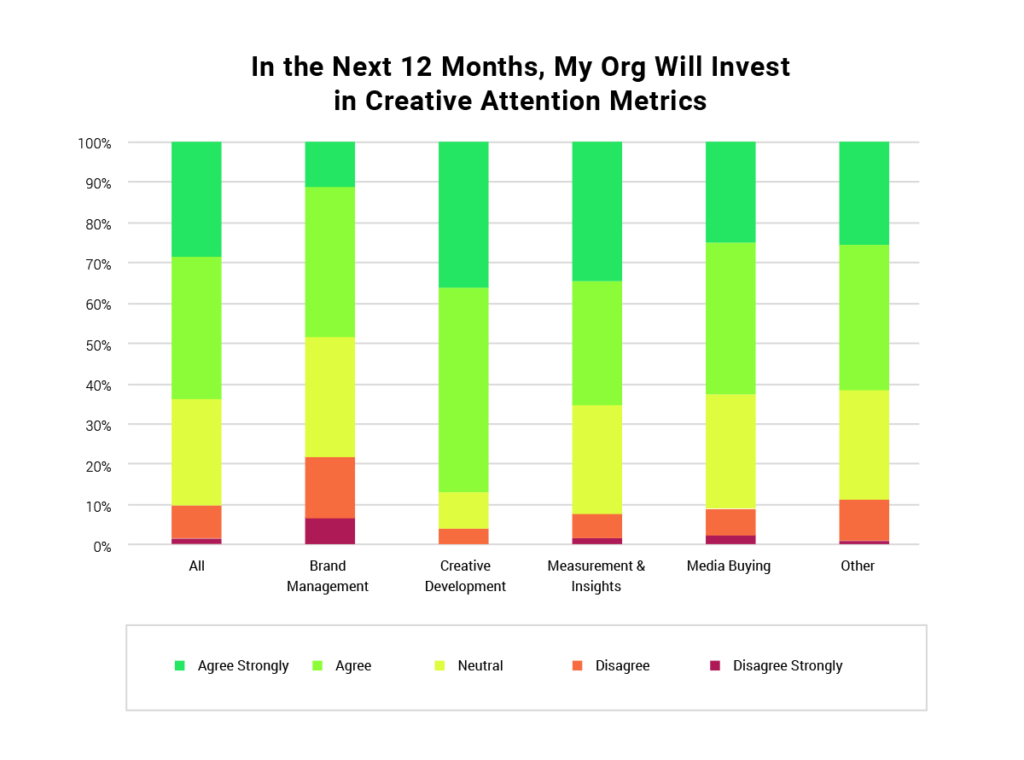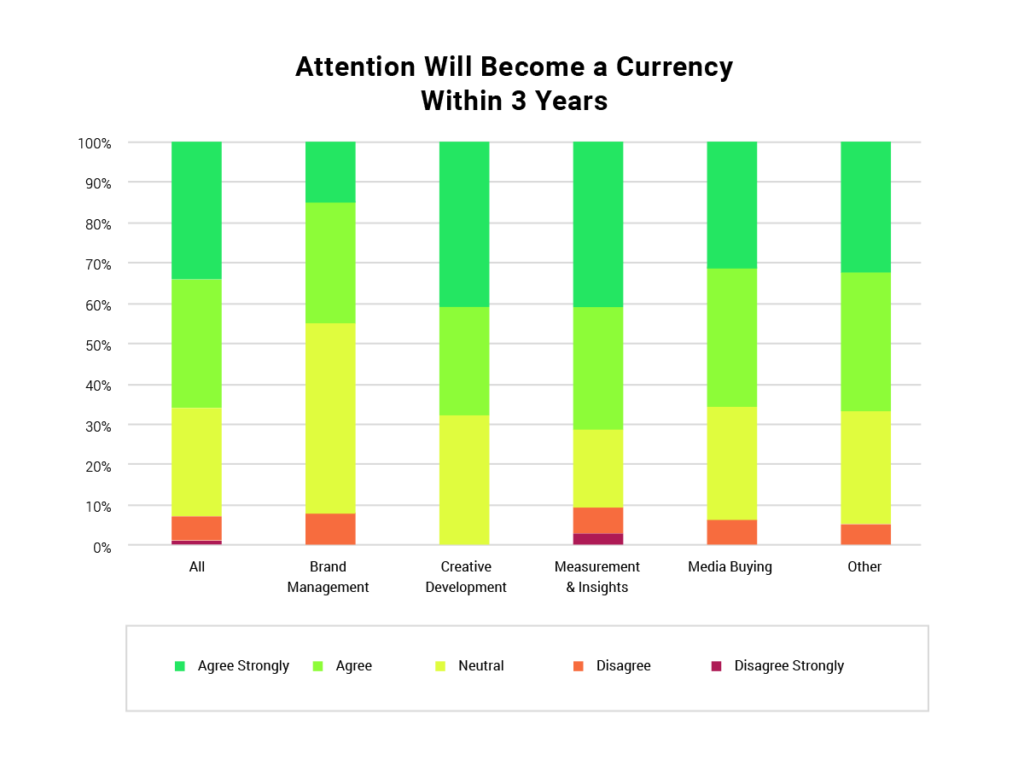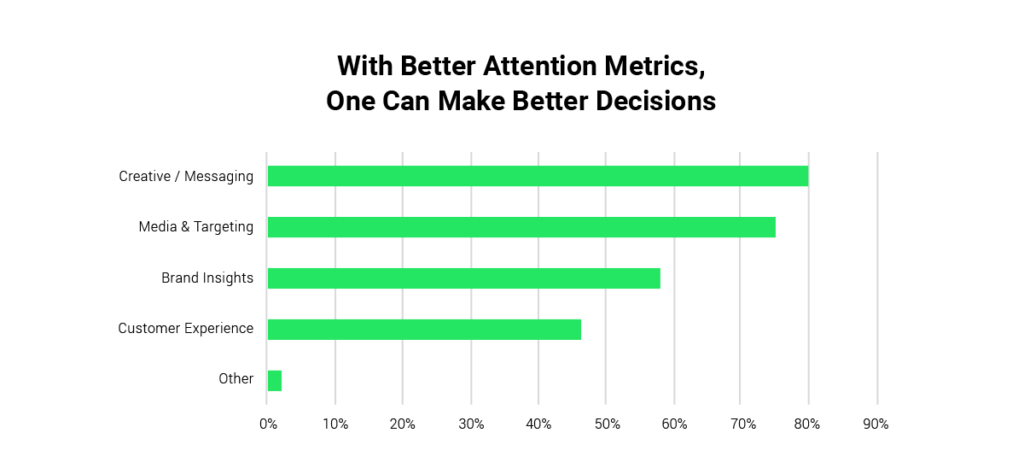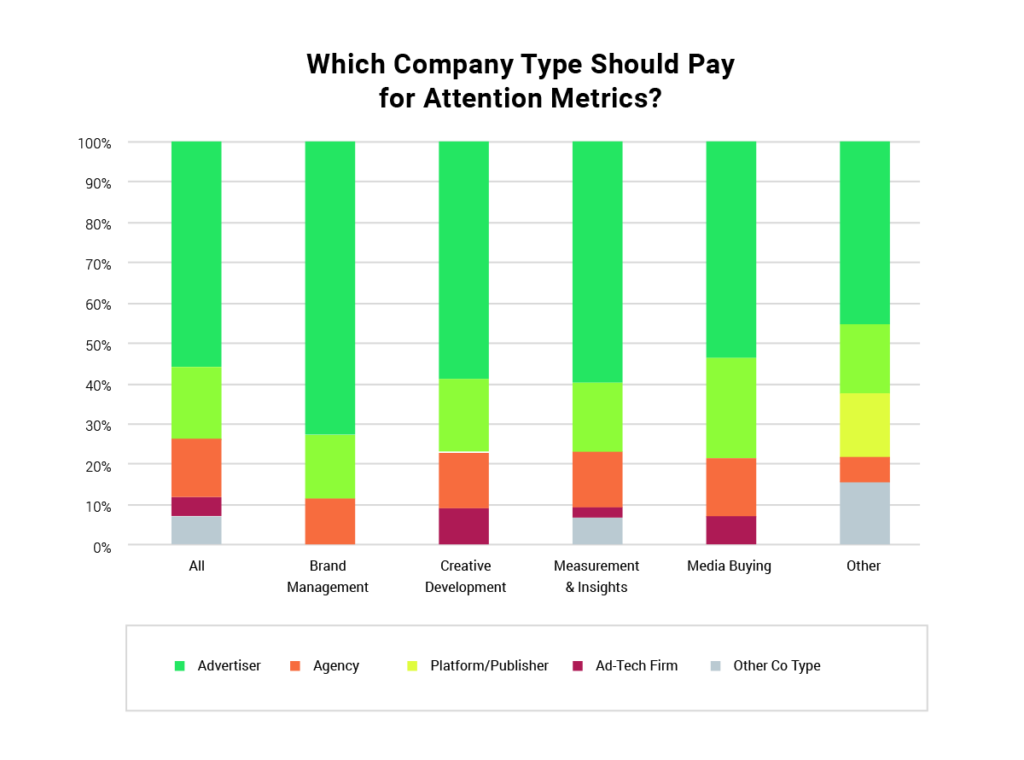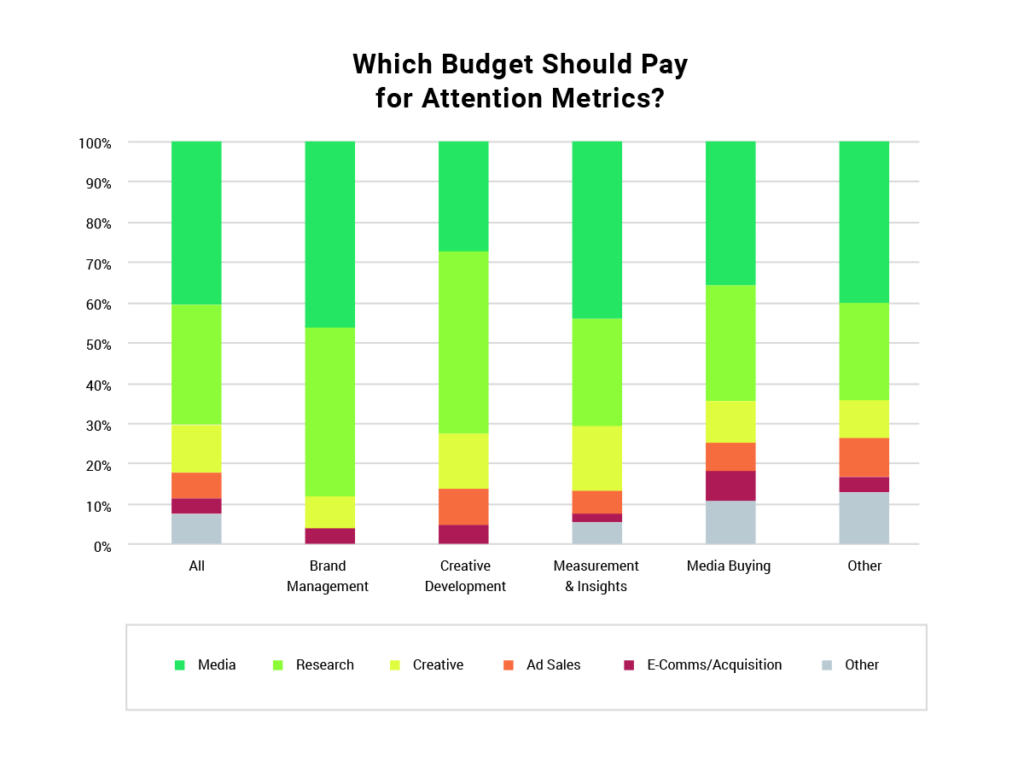What You Need to Know
- 90% of ad professionals report attention metrics are important, and 65% report that attention is a conversion stage in the sales and customer journey.
- Over half of ad pros report their organization will invest in creative and media attention metrics in the next 12 months.
- 55% of responders report that advertisers should pay for attention metrics, and media is the dominant budget (41%) that should pay for attention metrics, followed by research (29%).
What You Need to Do
Advertisers
- Advertisers and brand leaders – aka “the buy side” – are bullish on attention, though their enthusiasm lags other advertising professionals and company types. Therefore, advertisers should invest early to learn and prove the business case for attention because the upside is: competitive advantage, business insights, and greater campaign efficiencies and effectiveness. If you don’t invest, others will, and you will fall behind.
- First tap into experimental budgets and innovation centers to test the waters of attention metrics, but begin to think about operationalizing for scale across campaigns and partners should the business case prove itself out.
Platforms and Publishers
- Platforms need to embrace attention sooner than later because advertisers are increasingly demanding it. Advertisers must master media attention metrics, because most ad pros believe attention is an evolution of viewability, which is now table stakes. Know your media attention strengths and play to them, and address weaknesses.
- Platforms also must embrace creative attention metrics because creative is the greatest determinant of success or failure on any platform. Platforms can harness creative attention metrics to rationalize strong and poor campaign performance by an advertiser, and use them to optimize performance and guide advertisers to better outcomes.
AdTech Firms
- If you’re with an ad-tech firm pioneering attention metrics, it is critical to differentiate what makes your metrics unique and what is their predictive relationship to business outcomes. Hype is exploding and buyers need clarity and connection to results.
- While there is strong agreement that attention will become a currency, it is unlikely there will be a single metrics provider. Therefore, it is key to ensure attention data are extensible. Read and write APIs are critical for fusing attention data with other performance data and managing data and insights within various marketing stacks.
Agencies
- Agencies are among the least likely to directly pay for attention metrics, however they are a critical, influential stakeholder group for educating and activating attention metrics across advertisers and platforms. Large media buying firms have an opportunity to use attention metrics to achieve better outcomes through quality impressions, versus conventional “lowest cost” CPMs.
- Attention metrics are proving to be a powerful bridge between data silos of creative and media. Agencies have an opportunity to use attention data to unify creative, media and attention data for superior campaign outcomes and learning.
Adland is Paying Attention to Attention
“Attention is THE hot topic now,” an EVP of one of the top-three holding companies proclaimed to us in April 2022. Ad industry conferences are debating attention endlessly. Advertisers are developing attention POVs and sending out RFPs to partners. The Drum writes: Can attention metrics be the foundation to improving the online ad experience? Irwin Gotlieb, former CEO of WPP’s GroupM, believes it can become a primary currency.
Indeed, companies are creating real value with attention metrics. Realeyes’ case study with Mars, “Using Attention AI To Predict Real-World Outcomes,” was selected as a finalist in the ANA’s prestigious ECHO Marketing Data Strategy Awards. That case study attributed $30 million in ad cost savings due to attention metrics. Attention also was the dominant topic in other case studies presented at The Advertising Research Foundation’s recent Audience X Science conference. Innovators included Adelaide, Dentsu, Lumen Research, The NBA, Realeyes, Snap and TVision.
How important are attention metrics? Which ad stakeholders value them and why? Who should pay for attention metrics, and from which budgets? What is the business case for attention metrics? To answer these questions, we fielded our first “Attention in Advertising” business survey.
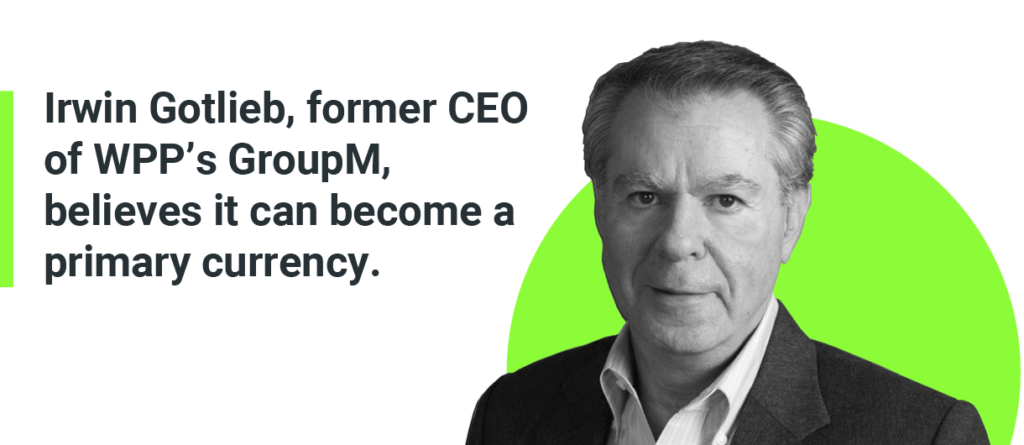
Methodology & Participants
We fielded the survey from March 3 – 12, 2022, and received 320 responders in the advertising industry. Respondents were recruited from Realeyes’ contact database, Linkedln and word of mouth, with strong participation from agencies (35%), brands (20%), platforms and publishers (20%), and ad-tech firms (25%).
In terms of job functions, 35% of responders worked in measurement and insights, 10% in media buying, 10% in brand management, 8% in creative development and the rest selected “other.” Our incentive for participants was a copy of the final report, and the opportunity to share candid views on the topic. The average duration to complete the survey was 2 minutes and 59 seconds. Lastly, our questions and analysis were informed by the Realeyes Attention Industry Advisory Board.
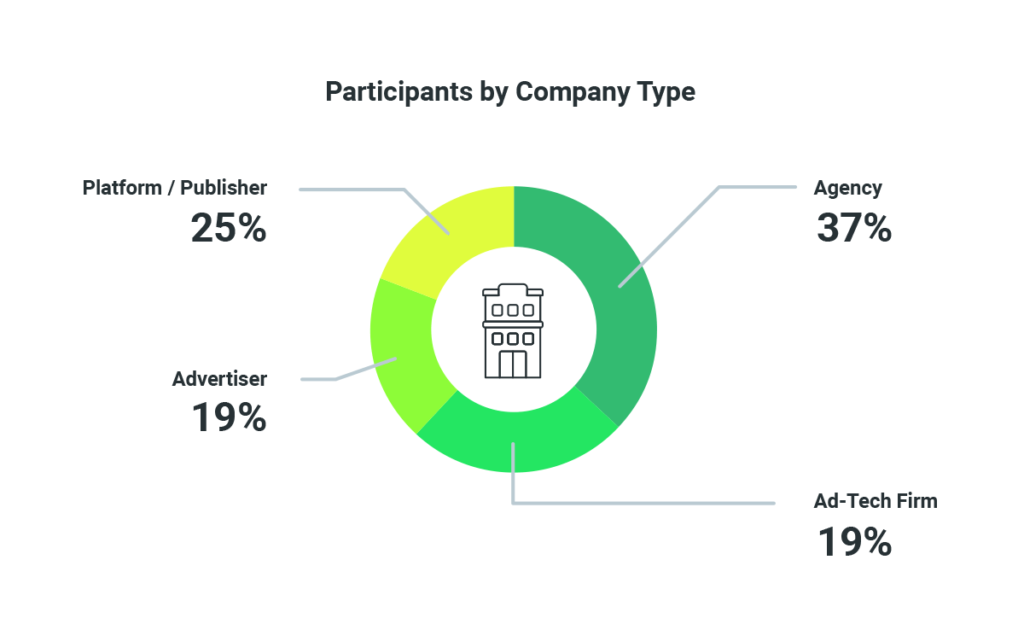
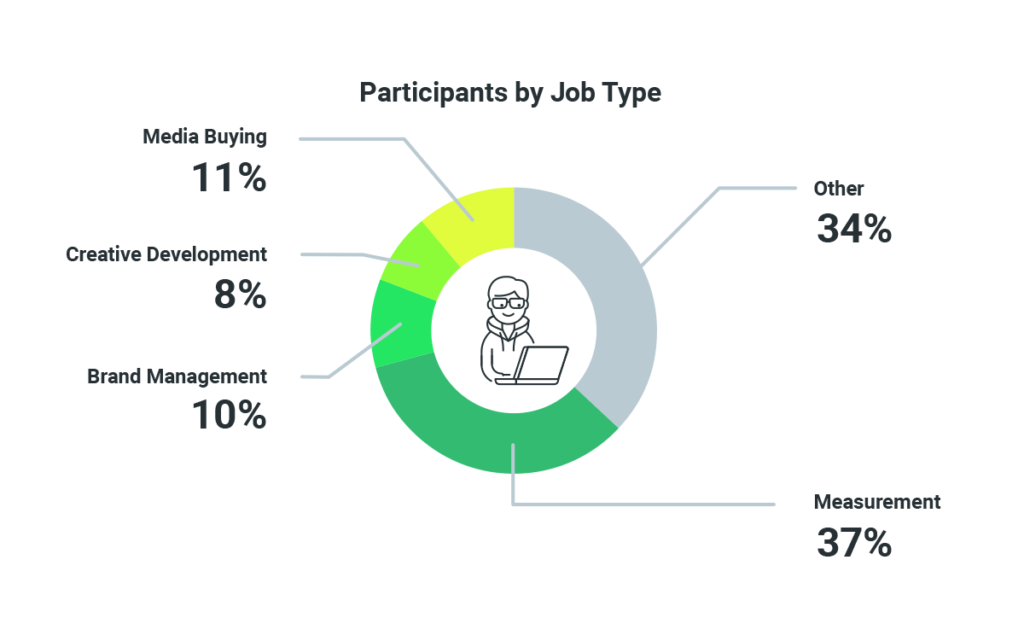
Adland Believes Creative is Most Important Factor Driving Advertising Success
Creative and media attention are critical, complementary factors influencing campaign outcomes. While media attention is driving recent hype, adland reports that creative is the dominant factor influencing campaign success. Media professionals is the only segment that reported media equally influential as creative.
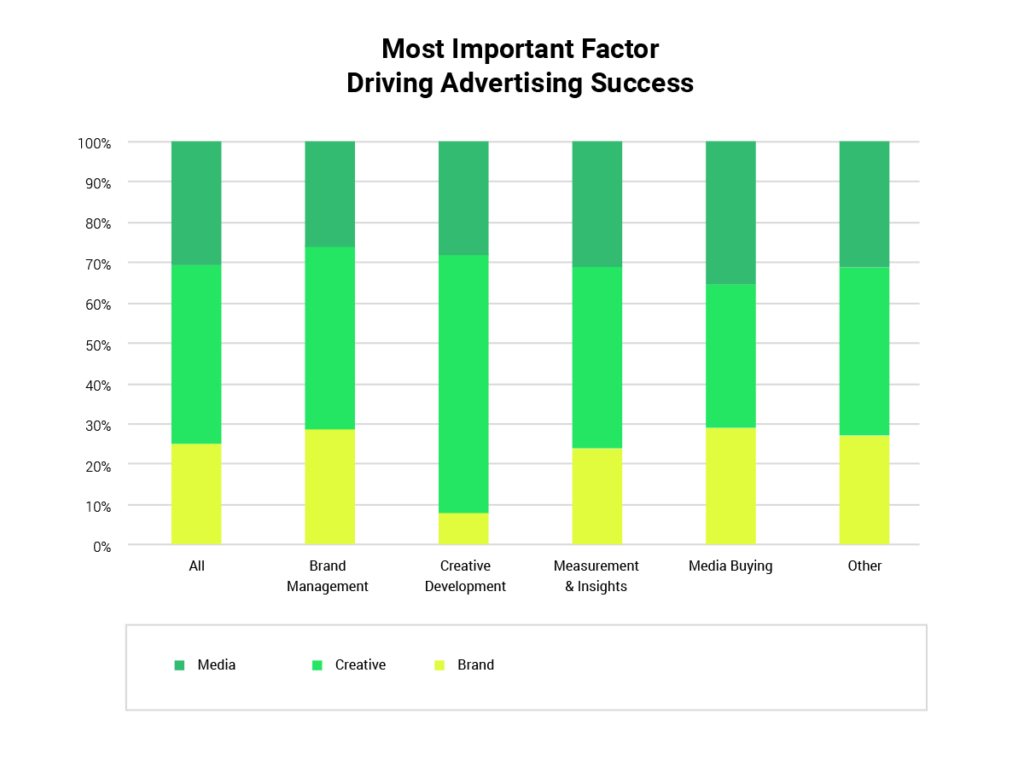
All of Adland Is Bullish on the Importance of Attention Metrics
Similar to functional personas, responders from all company types, report that attention metrics are important for business. Ad-tech firms and agencies are most strongly in agreement.
Adland is Hungry for Better Attention Metrics
A full 81% of respondents report their organizations are hungry for better attention metrics. Creative and measurement personas are most agreeable at 95% and 88%. Among brand leaders, perhaps earlier in their attention journey and still convincing their organizations, 56% report they agree or strongly agree.
Similar to functional personas, responders from all company types report their organizations are hungry for better attention data. Ad-tech firms and agencies are most strongly in agreement.
Attention is Earning its Place as an ‘Outcome’
Creative and media attention are not just niceties, because without attention, there is little else to follow. Attention increasingly is recognized as a business outcome in advertising. A full 65% of respondents agree or strongly agree that attention is a conversion stage in the sales and customer journey. Creative and measurement professionals are most in agreement at 77% and 70%, respectively, while media buyers are least at 47% agreement.
In terms of company types, responders from ad-tech firms are most in agreement that attention is a conversion stage at 74%, followed by advertisers at 67%, platforms at 62% and agencies at 60%.
Attention Poised to Become a Market with Established Buyers
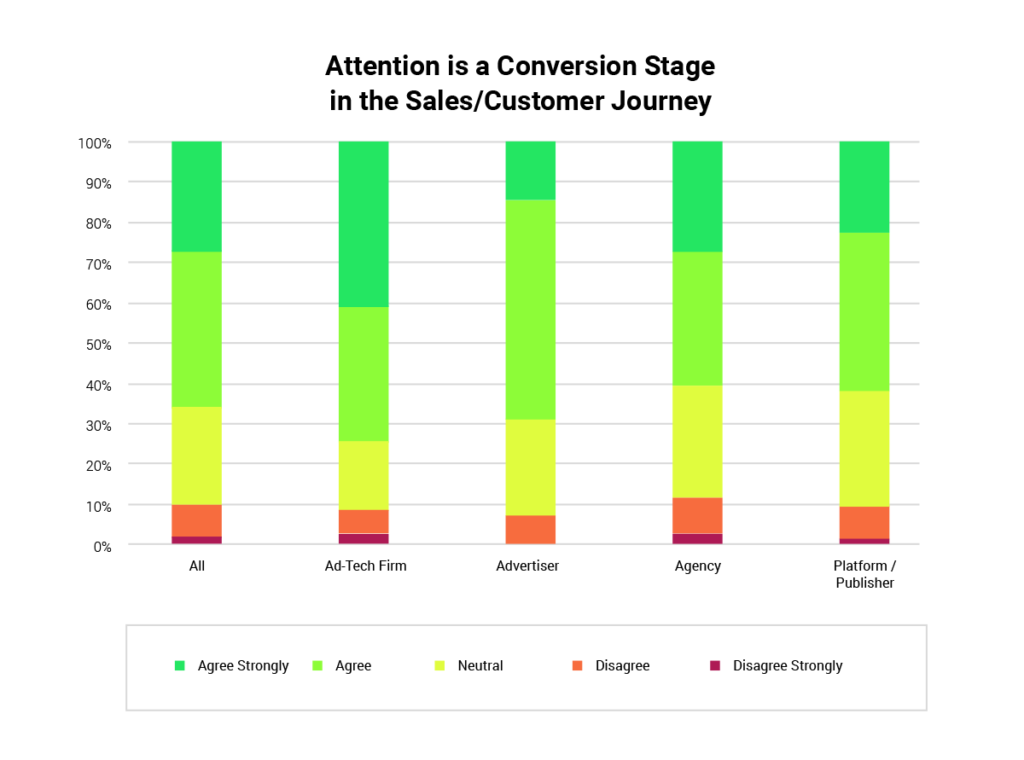
In the next 12 months, 56% of all responders agree or agree strongly that their organizations will invest in media attention metrics within the next 12 months. With the exception of brand management leaders, in agreement at 35%, well over half of responders for each persona report their organizations will invest in the next 12 months.
When it comes to creative attention metrics, responders are more bullish. A full 63% of all responders agree or strongly agree their orgs will invest in creative attention metrics in the next 12 months. Similar to media attention metrics, brand management leaders are laggards, with 48% in agreement. Within all other persona segments, 60% or more agree.
Adland Believes Attention Destined to Become Currency
Two-thirds of all respondents agree that attention will become a currency within three years. Similar to other attention topics, brand leaders lag in their enthusiasm. Amidst the brand management segment, 44% agree. That compares to all other segments ranging between 60% and 70% agreement.
Attention Metrics Most Useful for Creative and Media Decisioning
A full 80% of respondents report that attention metrics can enable better decisioning in creative and messaging, and 75% report they can enable better media and targeting decisions. Attention metrics also are perceived as useful for brand insights and customer experience. The order of decision use cases ranked similarly across all job personas and company types.
Adland Expects Advertisers to Pay for Attention Metrics, but Payments Will Happen Indirectly Through Platforms as Part of Media Investments
Overall, 55% of responders report that advertisers should pay for attention metrics, however fully 73% of brand management leaders report that advertisers should foot the bill. Platforms were next in line as accountable for paying for attention metrics.
There is an important nuance to this question, though. According to written comments, as well as offline interviews, there is a strong belief that advertisers are apex buyers, and inherently fund all metrics. In the long term, large, direct investments in attention metrics are likely to occur via platforms and publishers, and costs will be passed along to advertisers, integrated into CPMs or various incentive programs publishers use to lure and retain advertisers.
Indeed, the media sell-side is often the dominant, direct source of funding for various advertising and media metrics. This is underscored by media’s top ranking (41%) as the budget that responders most report should pay for attention metrics. Research (29%) is the second most popular budget for attention metrics, and perhaps this budget will be most reserved for advertisers’ most valuable, closely held contributor to campaign outcomes: their creatives.
Conclusion: It’s The Early Days of Attention, but the Window to Gain Advantage Is Now
The attention hype cycle is exciting, if not overwhelming. Regardless, the early proof points on attention metrics are too convincing to ignore. Now is the time to integrate attention metrics into your business learning agenda.
Fortunately, most attention innovators are not only transparent and eager to educate, but they are also committed to practical, science-based validation that leads to both short- and long-term wins. (See Realeyes’ strategy framework on Attentive Reach.) In addition to diligent trade reporters and academics, industry organizations like The Advertising Research Foundation, I-COM and the MMA are quickly developing a library of knowledge and thought leadership to satisfy their members’ growing interest in attention metrics. No matter your role or company in adland, your mandate is to engage and develop an attention agenda for your own organization.
Finally, we’re only at the beginning of the attention revolution. We look forward to collaborating with partners and the larger industry to advance the art and science of attention metrics. We also look forward to repeating our Attention in Advertising survey in another year, to gauge progress.
Please send any questions or feedback to max.kalehoff@realeyesit.com
About Realeyes
Realeyes is a leading attention data platform. Using front-facing cameras and the latest in computer vision and machine learning, Realeyes measures attention of opt-in participants as they watch video content online. This empowers brands, publishers and technology platforms to predict response and optimize their content, as well as target the right content to the right audiences. Founded in 2007, Realeyes has offices in New York, London, Tokyo and Budapest. Partners include brands such as Mars Inc, Church & Dwight, Hershey’s and Expedia, agencies Ipsos, Dentsu and Publicis, and platforms such as Google, TikTok, WarnerMedia and Teads.
Contents:
- What You Need to Know
- What You Need to Do
- Adland is Paying Attention to Attention
- Methodology & Participants
- Adland Believes Creative is Most Important Factor Driving Advertising Success
- All of Adland Is Bullish on the Importance of Attention Metrics
- Adland is Hungry for Better Attention Metrics
- Attention is Earning its Place as an ‘Outcome’
- Attention Poised to Become a Market with Established Buyers
- Adland Believes Attention Destined to Become Currency
- Attention Metrics Most Useful for Creative and Media Decisioning
- Conclusion: It’s The Early Days of Attention, but the Window to Gain Advantage Is Now
- About Realeyes
Share this:
